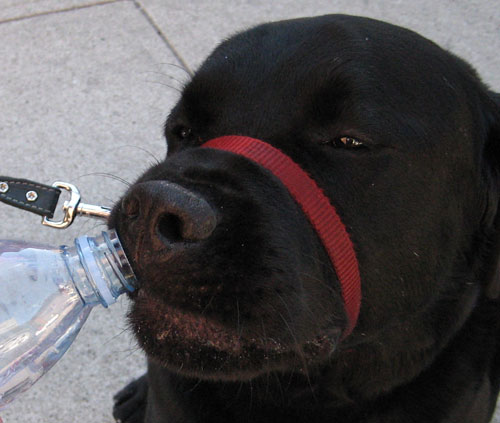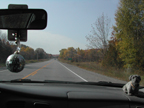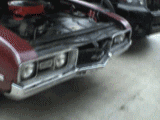
|
Lorna Mills and Sally McKay
Digital Media Tree this blog's archive OVVLvverk Lorna Mills: Artworks / Persona Volare / contact Sally McKay: GIFS / cv and contact |
View current page
...more recent posts
augh. sibling rivalry is always bad, but when one sibling gets a video made about their artwork with sexy German voice-over narration, it gets really really bad. Go here and click on "loss of signal."

I am going to have to pay more attention to detail if I am going to get through school. Of course, it is only the day before class that I realise one of the essays I've been reading is not required, and at the same time I have completly ignored an essay that is. D-oh! oh well, the one I wasn't supposed to read was pretty good. It's about explanation and description of artworks, and the various implications of different kinds of words and situations. Here's a bit that I thought I'd share, since it applies directly to L.M.'s dog, who is a force of nature, if not a work of art.
In everyday life if I offer a remark like "The dog is big", the intention and effect will depend a great deal on whether or not that dog is present or known to my hearers. If it is not, the 'big' — which, in the context of dogs, has a limited range of meaning — is likely to be primarily a matter of information about the dog; it is big, they learn, rather than small or middle-sized. But if it is present — if it is standing before us [perhahps rubbing it's gi-normous slobbery grinning head in your lap] as I talk—then 'big' is more a matter of my proposing a kind of interest to be found in the dog: it is interestingly big, I am suggesting. I have used 'dog' to point verbally to an object and 'big' to characterize the interest I find in it.
From Michael Baxandall's "Patterns of Intention" in The Art of Art History: A Critical Anthology, Donald Preziosi, ed. (Oxford, New York: Oxford University Press), 1998. pp. 59-60
I grew up hanging around the university where my dad taught, I've visited universities for work, and I have meaningful ongoing relationships with lots of people who have degrees from universities. So I guess I sort of thought I had and idea of what going to university might be like. As it turns out, it's an even more immersive world than I predicted, and I feel kind of like I'm travelling to another planet (shades of high school, where my main survival mechanism was to constantly mutter to myself "I'm an alien observer here" and watch The Man Who Fell to Earth repeatedly). But, as my dear friend and colleague Rev. Earl Chunx reminded me: "You can do it. It's a real thing in the world and it's good to know about it." And I do like the fact that educated adults have contracted to help me cram a bunch of potentially useful information into my (aging) noggin.
"Methodology" is the keyword for my first week. It's really important to have one. I am going to have to figure out how to get one without losing my bearings completely. Wikipedia says this:
Methodology refers to more than a simple set of methods; rather it refers to the rationale and the philosophical assumptions that underlie a particular study.So the beginning of the practice of studying art history seems to be mostly about studying the history of art history. I'm good with that! I like meta-levels. But, while dissecting the constructed narratives of western thought, it's a little tricky to figure out how I am going to participate in it.
The biggest change I can detect so far in my art-attitude is that, while I have always respected James Elkins with a certain interest and reserve, now he is my saviour and I am suddenly full of gratitude. His analyses of the history of art history are giving me a context for this whole school business that is helping me understand why I am so far feeling like an utter freak up there on the York U campus.
For instance, in this old Bad at Sports podcast, he talks about the fact that art critics are a separate breed from art historians, that criticism is not really part of academic methodology, and futhermore journalists who write about art for the popular press don't even register on the academic radar, despite the fact that in their worlds they feel very much like part of the bigger art picture. According to Elkins, most academics would never bother to cite a writer like Jerry Saltz. It's weird (is it true? I'll have to snoop around...). Elkins believes that ideas trickle down from academics to critics and curators, into the museums and popular press (really? I always thought it all got spread around sorta laterally and spiderwebby. If not - yike!). He also makes the strange suggestion that maybe journalists should do something that would make them impossible to ignore within academia (like...like what? Intriguing.)
There is an email going around, instigated by Richard Fung, that I want to re-post here (for the full version, with more info, see rabble.ca):
Dear friends and colleagues:4. DON'T FORGET your name, address, and postal code at bottom
You are being forwarded this email as a person who cares about Toronto.
Did you know the city's budget crisis could mean the end to theatres, galleries, festivals, concerts and all funding to writers, artists and musicians? It could also mean the end to libraries, community centres and health programs? Everything that makes Toronto one of the world's most livable cities.
Your action now can prevent this.
The city has never been closer to the brink. In just 30 seconds you can help avert cuts to the fabric of our city:
1. CREATE a new email, addressed to clerk@toronto.ca and cc'd to: dmcguinty.mpp.co@liberal.ola.org
hhampton-qp@ ndp.on.ca
john.tory@ pc.ola.org
2. TYPE the following subject line : "Yes to land transfer tax. Please copy to Mayor and City Councillors (arts)" (the clerk will forward it on to the Mayor and all the councillors: adding the arts in brackets means that arts friendly emails get tracked and tabulated)
3.PASTE this paragraph into the body of the email (or make up your own):Dear Mayor Miller and City Councillors:
My Toronto includes:the artsTo protect my city, I support the land transfer tax as an immediate solution to Toronto's financial crisis.
libraries
community centres
recreation programs
public health services
museums
and the TTC
Your name
Address
Postal code
5. SEND!
Please do this today. The city vote will likely be September 20!
10,000+ emails need to reach City Council this week. Each one will be read.
Please forward this call out widely.
The Road North/The Road South
Carlo Cesta, Michael Davey, John Dickson, Rebecca Diederichs, Brian Hobbs,
Lorna Mills, Lisa Neighbour, Chantal Rousseau, Lyla Rye, Kate Wilson and Johannes Zits.

In celebration of the Tree Museum's 10th Anniversary, Persona Volare was invited to mount an exhibition at Harbourfront's York Quay Centre. Opening Friday, September 14, 6-9 pm running until Sunday, November 4, 2007.

left to right: Kate Wilson, Carlo Cesta, Rebecca Diederichs
...then into the forest with GRANITE CLUB at the Tree Museum near Gravenhurst (Map) opening on Sunday September 16, 2007 noon to 5pm.

left to right: Michael Davey, Chantal Rousseau, Lorna Mills
